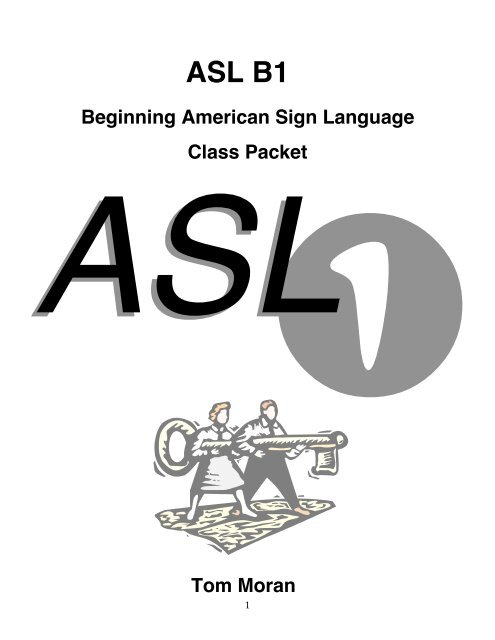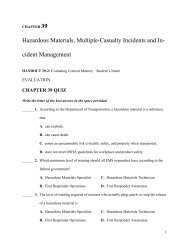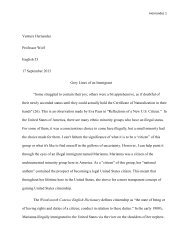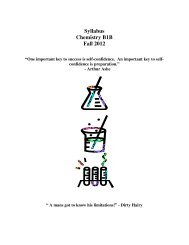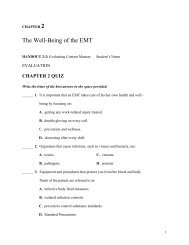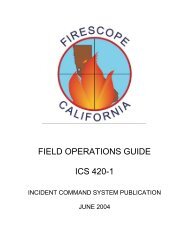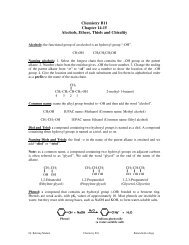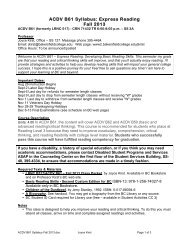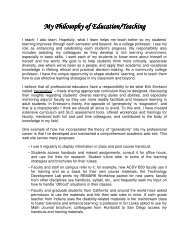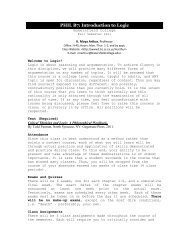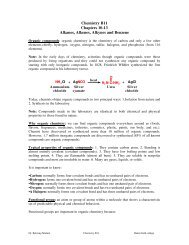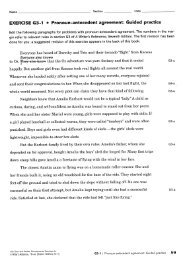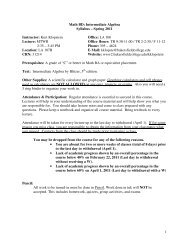ASL 1 Class Packet - Bakersfield College
ASL 1 Class Packet - Bakersfield College
ASL 1 Class Packet - Bakersfield College
You also want an ePaper? Increase the reach of your titles
YUMPU automatically turns print PDFs into web optimized ePapers that Google loves.
<strong>ASL</strong> B1<br />
Beginning American Sign Language<br />
<strong>Class</strong> <strong>Packet</strong><br />
<strong>ASL</strong>1<br />
Tom Moran<br />
1
<strong>ASL</strong> 1 <strong>Class</strong> <strong>Packet</strong> Index<br />
An Open Letter ......................................................................................3<br />
American Sign Language as a Foreign Language ..............................4<br />
Deaf Studies Terminology ....................................................................9<br />
Signing Naturally Curriculum ...........................................................13<br />
American Manual Alphabet ...............................................................15<br />
<strong>ASL</strong> Numbers 1-10 ..............................................................................16<br />
Fingerspelling in <strong>ASL</strong>..........................................................................17<br />
Fingerspelling RADAR .......................................................................18<br />
Verb Tense in American Sign Language ...........................................19<br />
Let There Be Light ...............................................................................20<br />
Minimal Pairs.......................................................................................21<br />
Spatial Agreement...............................................................................22<br />
Noun-Verb Pairs..................................................................................23<br />
Non-Manual Markers..........................................................................24<br />
Deaf Community Interaction..............................................................25<br />
Deaf Community Event Report..........................................................26<br />
Videotape Final Project .......................................................................27<br />
Videotape Grading Rubric..................................................................28<br />
Deaf Culture Poster Session ...............................................................29<br />
The <strong>Class</strong>room .....................................................................................32<br />
Hallway Activity Sheets......................................................................33<br />
Calendar Blank ....................................................................................35<br />
The Family ...........................................................................................36<br />
Watch & Mark Activity Sheets ...........................................................37<br />
Student Survey (Where Do You Live?) .............................................42<br />
Regional Quiz ......................................................................................43<br />
2
January 22, 2008<br />
Dear <strong>ASL</strong> Student:<br />
I’m pleased that you are taking my class. <strong>ASL</strong> is a fascinating subject and you<br />
should expect to learn a great deal about it and about the Deaf people who use it. I’m<br />
very interested in your success, but that is not something that happens automatically or<br />
without effort. Please allow me to offer you a bit of advice:<br />
1. This is a language workshop: you must be ever-present—no ifs, ands, or buts.<br />
2. In order to learn <strong>ASL</strong>, you must participate. You can’t negotiate your way out<br />
of this simple truth.<br />
3. Everyone in my class will treat one another with the utmost respect, including<br />
me:<br />
a. I won’t play favorites.<br />
b. I will assign you the grade you earn; nothing more, nothing less.<br />
4. I like to laugh and have fun. Let’s keep it that way.<br />
5. If you’re not sure about anything, ask—anytime.<br />
We are all students and we are all teachers. I expect that you will learn from me,<br />
and I expect to learn from you, too.<br />
I’m committed to your education and am prepared to help you in any way I can.<br />
I promise to support and encourage you, and that I will never belittle or humiliate you.<br />
If you’ve taken <strong>ASL</strong> with other teachers, you may see me do and sign things differently<br />
than they do. That’s good for you and will help your learning. There are other things<br />
that will help your learning: work hard, be diligent, do more than the minimum required,<br />
help your classmates, and always be in class.<br />
I’m looking forward to traversing the semester with you.<br />
3
American Sign Language as a Foreign Language<br />
Sherman Wilcox, Ph.D, Associate Professor<br />
Department of Linguistics, University of New Mexico<br />
Interest in American Sign Language (<strong>ASL</strong>) as a foreign language has become, in<br />
the words of Gary Olsen, former Executive Director of the National Association of the<br />
Deaf, "an American ground swell." Many colleges and universities are beginning to recognize<br />
the study of <strong>ASL</strong> and Deaf culture as legitimate academic pursuits and are<br />
starting to accept <strong>ASL</strong> in fulfillment of their foreign language entrance and exit requirements.<br />
In several states, <strong>ASL</strong> is mandated by law as acceptable in fulfillment of<br />
high school foreign language graduation requirements.<br />
More and more colleges and universities are accepting <strong>ASL</strong> in fulfillment of foreign<br />
language requirements. The University of California system (all campuses) will<br />
soon accept <strong>ASL</strong> in fulfillment of foreign language entrance and graduation requirements.<br />
Harvard and Yale are among some of the schools which are investigating similar<br />
action. Recently, we have witnessed tremendous activity by state legislatures to support<br />
the teaching and acceptance of <strong>ASL</strong> as a foreign language. Many states now recognize<br />
<strong>ASL</strong> as a foreign language for the purpose of meeting high school graduation requirements.<br />
In 1988, the parliament of the European Community, noting that there are<br />
500,000 profoundly deaf people in member states whose first language is their national<br />
signed language and not the dominant spoken language of their country, recognized as<br />
legitimate languages the indigenous signed languages of the twelve member states.<br />
Recognition and acceptance of signed languages is clearly an idea whose time has come<br />
on an international scale.<br />
4
Many questions come to mind when the topic of <strong>ASL</strong> as a foreign language is<br />
brought up. People often ask if it is appropriate to call <strong>ASL</strong> a foreign language. Is it<br />
really a language? Isn't it a derivative of English, on the order of Black English? Is <strong>ASL</strong><br />
"foreign"?—after all, it is used in the United States. Is there a body of literature associated<br />
with <strong>ASL</strong>? Others may note that foreign language courses teach students about the<br />
culture of the group of people who use the language. They may wonder if there is a full<br />
and distinct culture associated with users of <strong>ASL</strong>.<br />
The answers to all of these questions support the recognition of <strong>ASL</strong> as a foreign<br />
language. Because of its unique modality—visual/gestural rather than aural/oral—<br />
many people wrongly assume that <strong>ASL</strong> is fundamentally different than spoken languages.<br />
<strong>ASL</strong> is a fully developed human language, one of the hundreds of naturally occurring<br />
signed languages of the world. It is not a derivative of English. It is not a "simplified"<br />
language—it contains structures and processes which English lacks (such as<br />
<strong>ASL</strong>'s rich verbal aspect and classifier systems). There is abundant linguistic research on<br />
<strong>ASL</strong> demonstrating that the grammar of <strong>ASL</strong> is radically different from English—surely<br />
as different as any of the more traditional foreign languages taught in school. Comprehensive<br />
sources of information on the linguistics of <strong>ASL</strong> are Linguistics of American Sign<br />
Language by Clayton Valli and Ceil Lucas (1993, Gallaudet University Press), American<br />
Sign Language: Linguistic and Applied Dimensions by Ronnie Wilbur (1987, Little Brown<br />
and Co.) and The Signs of Language by Edward Klima and Ursula Bellugi (1979, Harvard<br />
University Press).<br />
The question of whether <strong>ASL</strong> is "foreign" depends on what we mean by foreign.<br />
<strong>ASL</strong> is not universal; it is indigenous to the United States and parts of Canada. This<br />
should not, however, exclude it from study as a foreign language. The question also<br />
arises with other languages indigenous to North America. At the University of New<br />
5
Mexico, for example, Navajo is taught and accepted in fulfillment of the foreign language<br />
requirement, yet it is not used in a foreign country. For reasons such as this,<br />
many language scholars now speak of second language, rather than foreign language,<br />
requirements.<br />
Some people may suggest that <strong>ASL</strong> lacks an international scope. In the hearing<br />
world of international world affairs this is true. It is also true for many of the spoken<br />
languages traditionally accepted to fulfill foreign language requirements. On the other<br />
hand, in the Deaf world, <strong>ASL</strong> is quite an important language on the international scene;<br />
for example, <strong>ASL</strong> is often an official language of international conferences.<br />
There is a rich body of <strong>ASL</strong> literature by and about Deaf people, as well as texts<br />
on <strong>ASL</strong> in both written and oral modes. The folk heritage of Deaf people, passed down<br />
through generations of <strong>ASL</strong> users, includes legends, naming practices, tall tales, jokes,<br />
word play, games, poetry, customs, rituals, and celebrations. For more examples of the<br />
heritage and folklore of Deaf people, Jack Gannon's Deaf Heritage: A Narrative History of<br />
Deaf America (1981, National Association of the Deaf) is an excellent resource.<br />
Foreign language study necessarily involves learning about the values, worldview,<br />
and way of life—the culture—of a group of people. The same is true for the study<br />
of <strong>ASL</strong>. <strong>ASL</strong> students learn about the rich cultural life of Deaf people. Deaf culture is<br />
now recognized and studied by anthropologists, ethnographers, folklorists, and others<br />
interested in culture and cross cultural communication. One excellent description of<br />
Deaf culture is the recent book by Carol Padden and Tom Humphries, Deaf in America:<br />
Voices from a Culture (1988, Harvard University Press). American Deaf Culture: An Anthology,<br />
by Sherman Wilcox (Linstok Press, 1989), contains several articles presenting a variety<br />
of perspectives on the language and culture of Deaf people in America. Oliver<br />
Sacks' recent book, Seeing Voices (University of California Press, 1989) is an introduction<br />
6
to Deaf culture, <strong>ASL</strong>, and the struggle of Deaf people to gain control of their individual<br />
and community identity.<br />
The facts are overwhelming. <strong>ASL</strong> is a true human language fully distinct from<br />
English with its own literature and culture. It is important to go beyond these facts,<br />
however, and to ask whether, by offering <strong>ASL</strong> as a foreign language option, we do students<br />
an injustice by steering them away from courses which could be of more intellectual<br />
or economic value. Is <strong>ASL</strong> instruction a worthwhile addition to the curriculum?<br />
The answer clearly is "Yes—absolutely!" One of the educational benefits of foreign<br />
language study is that it gives students a fresh perspective on their own language<br />
and culture. This is especially true of <strong>ASL</strong>. Applying linguistic and anthropological<br />
methods to the study of <strong>ASL</strong> and Deaf culture is an excellent intellectual exercise for<br />
students. It leaves them with a better understanding of another people's language and<br />
customs, as well as a deeper appreciation of their own language and culture.<br />
We do not teach languages only for the intellectual rewards. There are also practical,<br />
economic reasons for learning a foreign language. For example, our nation's businesses<br />
need employees who can understand the language and customs of foreign people.<br />
This might seem to work against <strong>ASL</strong> because it is not associated with a foreign nationality.<br />
Again, the facts do not support such a contention. For example, students in the<br />
bachelor of science degree program in sign language interpreting at the University of<br />
New Mexico are regularly recruited into competitive positions in business, education,<br />
and government. Many students report that they take <strong>ASL</strong> specifically to make them<br />
better qualified or more employable in non-deafness related careers. Those students<br />
who want to continue their education at the graduate level find that a background in<br />
<strong>ASL</strong> opens up several avenues for advanced study and research.<br />
7
Finally, some might wonder whether offering <strong>ASL</strong> as a foreign language option<br />
will cause a decline in enrollment in other foreign languages. The evidence from those<br />
universities which accept <strong>ASL</strong> as a foreign language is precisely the opposite. At these<br />
universities there is no record of a decrease in traditional foreign language enrollment<br />
due to enrollments in <strong>ASL</strong>. As a matter of fact, <strong>ASL</strong> instruction may lead to increased<br />
foreign language enrollment. <strong>ASL</strong> students often report that they are more interested in<br />
other languages—and indeed more likely to take a traditional, spoken foreign language—as<br />
a result of their <strong>ASL</strong> study. The joy of learning a new language and of communicating<br />
with people across cultural boundaries, it seems, is contagious!<br />
Students who know a foreign language commonly find that their perceptions of<br />
themselves and the world are richer than their monolingual peers. The study of a language,<br />
culture, and literature different than their own propels students beyond the limits<br />
of their own world. In all respects <strong>ASL</strong> affords students the same challenges and rewards<br />
as more traditional foreign languages.<br />
Copyright 1991 Sherman Wilcox<br />
http://www.unm.edu/~wilcox/<strong>ASL</strong>FL/asl_fl.html<br />
8
Deaf Studies Terminology<br />
1. <strong>ASL</strong>: American Sign Language. The everyday language of nearly one million<br />
Americans. It is commonly believed that <strong>ASL</strong> is the third most commonly used language<br />
in the U.S., but this is not the case; however, it is a popular language. It is<br />
based largely on French Sign Language (LSF) and was brought to the U.S. by<br />
Laurent Clerc, a French educator of Deaf children who partnered with Thomas Gallaudet<br />
to open the first public school for Deaf people in 1817.<br />
2. Deaf: Note the capital “D”; this is the term is used to describe members of North<br />
American Deaf Culture. Note the capital “D,” which denotes a proper noun, much<br />
in the same way you might refer to someone as “Chinese” or a “Black American.”<br />
Refer to people who have a hearing loss and are members of a culture as “Deaf people”<br />
or “people who are Deaf.” Never refer to them as “the Deaf” or in a manner<br />
such as “I saw a Deaf.”<br />
3. deaf: This term is used to describe an auditory pathology, that is the inability to<br />
hear, or hear well enough to transact a spoken conversation. The term “deaf” with a<br />
lowercase “d” is used to describe the condition of deafness or a person who is not a<br />
member of American Deaf Culture.<br />
4. deaf and dumb: This is another opprobrious term from times gone by. Here the<br />
term “dumb” means unable to speak; unfortunately, it’s homonym means “unintelligent.”<br />
Too often Deaf individuals are perceived of as unintelligent or incapable,<br />
and usually this is not the case. This was a very common term and you will see it<br />
still, from time to time, in the media. Never use this term.<br />
5. Deaf Culture: See Deaf World.<br />
6. deaf-mute: This was a term popular up until the mid-20 th century. It is no longer<br />
used and has become opprobrious. It incorrectly describes people who are Deaf. The<br />
9
inability to hear makes it very difficult to modulate one’s voice and to pronounce<br />
words correctly; however, almost all Deaf people possess the power of speech.<br />
Rarely is a Deaf person actually “mute,” though many choose not to speak.<br />
7. Deaf World: This is a somewhat antiquated term, the way in which Deaf people<br />
used to refer to their collective experience: no telephones, residential schools, menial<br />
jobs, Deaf spouses, etc. Typically we now refer to the collective experience of North<br />
American Deaf people (and Deaf people from around the world) as Deaf Culture.<br />
8. death: For reasons that are a mystery to me, many students refer to Deaf people as<br />
“death.” While sometimes humorous (“I see deaf people. . . .”) it can be offensive<br />
and make you look ignorant—which you are not. When people ask me if I work<br />
with “the death,” I reply, “Yeth.”<br />
9. facial expressions: Facial expressions are emotive and universal. In every culture<br />
the same facial expressions means, “OW! I just hit my thumb with a hammer,” or<br />
“Gee, I love you.” People who don’t understand sign language often confuse <strong>ASL</strong>’s<br />
non-manual grammar with emotive facial expressions, leading them to conclude<br />
that “<strong>ASL</strong> is SO expressive!”<br />
10. gesture: The use of movement to convey a message; more purposeful than body<br />
language, but not a language governed by a grammar. One uses basic invented<br />
gestures to play that party game Charades. Someone who is skilled at gesture—like a<br />
certified deaf interpreter—can communicate quite effectively with individuals who<br />
have little expressive or receptive language.<br />
11. hearing: This is the term applied to people who have no hearing loss. Most of the<br />
students who take my class are hearing. Do not refer to hearing people as “speaking.”<br />
All too often people confuse the ability to speak with the ability to think or reason;<br />
on the contrary, if you listen talk radio, you will quickly learn that there is no<br />
10
link between the ability to speak and the ability to think. Almost all Deaf people are<br />
capable of speech but choose to sign, as it is easier and more comfortable—in a<br />
word, natural.<br />
12. hearing impaired: Much has been said and written on the origin of this term. Some<br />
think it is politically correct. Others think it is an economics term coined to talk<br />
about 20,000,000 Americans—many of them elderly—who have some significant<br />
form of hearing loss. It does not refer to members of a culture, and Deaf people<br />
rarely refer to themselves as “hearing impaired.”<br />
13. Interpreter: An individual trained in interpreting and transliterating who is fluent in<br />
at least two languages, in our case English and <strong>ASL</strong>.<br />
14. MCE: Manually-Coded English. Whereas <strong>ASL</strong> is its own language, many people<br />
(most of them hearing) believe that if teachers sign in English word order, with<br />
symbols invented to mimic our syntax and phonology, Deaf students will improve<br />
their written English. This method has been tried since at least the early 18 th century.<br />
An experiment as old as deaf education itself, it is largely a failure.<br />
15. manual communication: Communicating using the hands and “body language.” Its<br />
counterpart is verbal communication.<br />
16. non-manual behavior: A form of communication which is non-verbal as well as<br />
non-manual, that is not on the hands. Non-manuals are movements of the face,<br />
head, shoulders, and upper body which have grammatical meaning in <strong>ASL</strong>. For example<br />
if you tilt your head to your shoulder, you are indicating spatial or temporal<br />
immediacy (he’s right there; she just left). If you raise your eyebrows, you are asking<br />
a yes/no question. Non-manual behaviors are sometimes referred to as the grammar<br />
of <strong>ASL</strong>.<br />
11
17. Oralism: This is a method of instruction wherein a teacher mouths every word to a<br />
Deaf person and asks the Deaf person to learn to speak normally in spite of his inability<br />
to hear himself. A product of the Victorian age—and the preferred method of<br />
instruction in most countries around the world—it was standard procedure in the<br />
U.S. until the 1970s. There are schools that practice this method to this day. Many<br />
Deaf people are raised and educated by the oral method. A vast majority of them<br />
turn to <strong>ASL</strong> at some point in their lives. I have never known a Deaf person to grow<br />
up signing and later become oral.<br />
Pidgin Signed English: See “MCE”<br />
SEE: See “MCE”<br />
Signed English: See “MCE”<br />
Signer: Someone who signs. Often you will see someone signing for a Deaf person in a<br />
classroom or at a performance. While that individual is often referred to as a<br />
“signer,” he is actually an interpreter/transliterators. Interpreters actually interpret<br />
from one language into another language, <strong>ASL</strong> to English for example. Transliterators<br />
translate from one language to another form of the same language, spoken English<br />
to signed English, for example.<br />
12
The Signing Naturally Curriculum<br />
As you know by now, the text we are using for this course is Signing Naturally,<br />
Level I. This is the book I use to teach both <strong>ASL</strong> 1 and <strong>ASL</strong> 2. For those students continuing<br />
in their studies, I use Signing Naturally, Level 2 for <strong>ASL</strong> 3, and portions of Signing<br />
Naturally Level III for <strong>ASL</strong> 4 and beyond. I chose this text series carefully for a number of<br />
reasons which I would like to share with you.<br />
1. Two of the three authors of this text series are Deaf; the hearing author is a CODA,<br />
the child of Deaf adults. All three are native users of <strong>ASL</strong>. Each is a pioneer in <strong>ASL</strong><br />
instruction and they are teachers of <strong>ASL</strong> teachers. (It may interest you to know that<br />
your instructor has trained with them.) They are <strong>ASL</strong> interpreters, linguists, poets,<br />
and each has an advanced degree in language or linguistics.<br />
2. Signing Naturally is the best and most-widely used—by far—<strong>ASL</strong> text book available.<br />
If you came from a high school or college that offered <strong>ASL</strong>, you likely used this<br />
book. If you plan to transfer and continue your studies elsewhere, you will likely use<br />
this textbook series. Among the colleges that use—and endorse—this text are Gallaudet<br />
University (in their Center on <strong>ASL</strong> Literacy), CSU Northridge, CSU Hayward.<br />
San Diego State University, and the University of California at San Diego, just to<br />
name a few.<br />
3. This text series uses the most modern second-language teaching methods. Whereas<br />
in the past <strong>ASL</strong> has been taught by listing vocabulary or transcribing English sentences,<br />
Signing Naturally uses a functional/notional approach. This means <strong>ASL</strong> is<br />
taught using <strong>ASL</strong>, emphasizing “communicative purpose” in the language we are<br />
studying. It means <strong>ASL</strong> is taught emphasizing the functions of language use in<br />
situations students are likely to encounter outside the classroom.<br />
4. Finally, the Signing Naturally text series teaches <strong>ASL</strong> in a way that is respectful of<br />
<strong>ASL</strong> and members of Deaf culture. To begin with, it encourages a “no-voice” policy.<br />
13
This can be unsettling to students who are not accustomed to guessing and feeling<br />
“off-balance” in a classroom; however, I assure you that it is the quickest and most<br />
effective way to learn <strong>ASL</strong>. In addition, Signing Naturally eschews the use of English<br />
“glosses” in labeling signs. A gloss (usually written in all caps, like CAT) is a label,<br />
printed in English, below the picture of a sign. While common sense would reason<br />
that this would enhance learning, the opposite is actually true. The overwhelming<br />
majority of signs can be translated into several, sometimes dozens, of different English<br />
words. To label a sign with a single English word is to do a grave disservice to<br />
an <strong>ASL</strong> student, and leads students to asking such ignorant questions as “What’s the<br />
sign for ‘run,” where, in fact there are literally dozens of signs for that single English<br />
word, even more than there are definitions of that word.<br />
As you can tell, I think highly of this textbook series. I chose it to make both your life<br />
and my life easier, and because I think if you use this book to its fullest intent and if you study<br />
hard, you will leave this class a competent, beginning <strong>ASL</strong> user who is comfortable conversing<br />
with a stranger.<br />
14
Did you know that. . . .<br />
. . . <strong>ASL</strong> has recorded the fastest enrollment growth rate (over 400%) of any “foreign<br />
language” offered on U.S. college campuses, according to the Modern Language Association?<br />
. . . origins of <strong>ASL</strong> can be traced to Martha’s Vineyard in the late 1600s?<br />
. . . in the U.S. approximately 500,000 people use <strong>ASL</strong> as their primary language?<br />
. . . more than 150 colleges and universities recognize <strong>ASL</strong> as a language in its own<br />
right?<br />
Source: Los Angeles Times, January 18, 2005<br />
16
Fingerspelling in <strong>ASL</strong><br />
Try reading the following paragraph quickly:<br />
The pweor of the hmuan mnid<br />
Aoccdrnig to a rscheearch at Cmabrigde Uinervtisy, it deosn't mttaer in what oredr the<br />
ltteers in a wrod are, the olny iprmoetnt tihng is taht the frist and lsat ltteer be at the rghit pclae.<br />
The rset can be a total mses and you can sitll raed it wouthit any porbelms. Tihs is bcuseae the<br />
huamn mnid deos not raed ervey lteter by istlef, but the wrod as a wlohe.<br />
Not that hard, is it? This demonstrates the fallacy of trying to see each letter when reading<br />
fingerspelled words. Many Deaf children—children not old enough to read—can understand<br />
many fingerspelled words. That’s because they recognize the words as whole units, rather<br />
than as a series of letters. Being able to recognize all the words in the above paragraph is an example<br />
of the three Cs of fingerspelling—Context, Clozure, and Configuration.<br />
Context: Once you determine the paragraph is a report on scientific research, that reduces<br />
the number of possible words you might encounter.<br />
Clozure: Because you see the first and last letter of each word in its proper place, it’s<br />
much easier to determine what the word is. Similarly, though you may miss some of the internal<br />
letters in a fingerspelled word, you can usually see the first and last letter.<br />
Configuration: The capitalized letters denote proper nouns (Cambridge University) as<br />
well as the beginnings of sentences. Additionally, some words seem to have a unique “shape”:<br />
research, important, without, and whole. Even scrambled, these words stand out in the paragraph.<br />
17
18<br />
A<br />
B<br />
A<br />
B<br />
B<br />
A<br />
C<br />
B<br />
A<br />
D<br />
B<br />
A<br />
E<br />
B<br />
A<br />
F<br />
B<br />
A<br />
G<br />
B<br />
A<br />
H<br />
B<br />
A<br />
I<br />
B<br />
A<br />
J<br />
B<br />
A<br />
K<br />
B<br />
A<br />
L<br />
B<br />
A<br />
M<br />
B<br />
A<br />
N<br />
B<br />
A<br />
O<br />
B<br />
A<br />
P<br />
B<br />
A<br />
Q<br />
B<br />
A<br />
R<br />
B<br />
A<br />
S<br />
B<br />
A<br />
T<br />
B<br />
A<br />
W<br />
B<br />
A<br />
X<br />
B<br />
A<br />
Y<br />
B<br />
A<br />
Z<br />
B<br />
A<br />
U<br />
B<br />
A<br />
V<br />
B<br />
A<br />
G<br />
B<br />
A<br />
Fingerspelling<br />
RADAR
Verb Tense American Sign Language<br />
Distant<br />
Near<br />
Recent<br />
Distant<br />
Future<br />
Future<br />
Past<br />
Past<br />
Future<br />
PRESENT<br />
Past<br />
19
Let There Be Light<br />
One reason that it is troublesome to label signs with glosses (for a definition of “gloss”<br />
see pg. 11) is that one English word can have a dozen or more sign possibilities and vice<br />
versa. As a simple example of just how complex this issue can be, how would you sign<br />
the following sentences?<br />
1. Will you light the fire for me please?<br />
2. Turn out the lights please.<br />
3. She was wearing a coat that was too light and almost froze.<br />
4. She made light of the situation.<br />
5. She had on a light blue dress.<br />
6. There isn’t enough light in here.<br />
7. I ate a light lunch.<br />
8. I slept very light last night.<br />
9. The medicine made me very light-headed.<br />
10. I painted light yellow on the wall last night.<br />
20
Minimal Pairs<br />
There are five parameters for almost every sign; they are<br />
1. Location<br />
2. Handshape<br />
3. Movement<br />
4. Palm Orientation<br />
5. Non-Manual<br />
A minimal pair is two signs that differ only by one parameter. Examples:<br />
Location: FUNNY – SUGAR Movement: VOTE – TEA<br />
SEE – VOICE<br />
UGLY – DRY – SUMMER<br />
MISS – THINK<br />
FAKE-MOUSE<br />
MAKE – COFFEE<br />
FULL – ENOUGH<br />
Handshape: WHITE – LIKE Palm Orientation: THING – CHILDREN<br />
KNOW – THINK<br />
CAR – WHICH<br />
ESTABLISH – APPT.<br />
SCHOOL – PROOF<br />
Non-Manual: NAKED – AVAILABLE<br />
21
Spatial Agreement<br />
1. To show that a location or person is far away:<br />
a. Head: tilted<br />
b. Eyes: squinted<br />
c. Mouth: open slightly<br />
d. Index finger: trace route, extend arm fully<br />
2. To show that a location or person is at a moderate distance:<br />
a. Head: tilted<br />
b. Eyes: normal<br />
c. Mouth: purse lips slightly, “mm”<br />
d. Index finger: trace route, extend arm moderately, about half way<br />
3. To show that a location or person is very near:<br />
a. Head: tilt to the dominant side with cheek almost touching raised<br />
shoulder<br />
b. Eyes: wide open<br />
c. Mouth: teeth clenched, “cs”<br />
d. Index finger: trace route, keep hand close to body and no arm extension<br />
22
Noun-Verb Pairs<br />
One of the important distinctions of <strong>ASL</strong> grammar is its verb-modulation system.<br />
Whereas in English we modify a verb by changing its spelling, in <strong>ASL</strong> we modulate a<br />
verb with movement. Like English, many verbs are based on nouns. In <strong>ASL</strong>, a noun is<br />
gently “bounced” to indicate they are nouns. Many verbs move to show the direction of<br />
the action.<br />
Nouns<br />
Verbs<br />
1. AIRPLANE FROM-FLY-TO<br />
2. AIR PUMP PUMP AIR<br />
3. BABY ROCK-baby-IN-ARMS<br />
4. BACKPACK PUT-ON-BACKPACK<br />
5. BATH BATHING<br />
6. BED GO-TO-BED<br />
7. BICYCLE RIDE-bicycle<br />
8. BOAT GO-BY-BOAT<br />
9. BOOK OPEN BOOK<br />
10. CAMERA TAKE-PICTURE<br />
11. CAR DRIVE-car<br />
12. CHAIR SIT<br />
13. CIGARETTE SMOKE<br />
14. COAT PUT-COAT-ON<br />
15. COMB COMB-HAIR<br />
16. DOOR OPEN/CLOSE-DOOR<br />
17. FOOD EAT<br />
23
Non-Manual Markers<br />
Also known as “Non-Manuals” (NMs), these facial expressions are not emotive; they<br />
are grammatical. One’s eyebrows signal whether one is asking a yes/no question, an<br />
information question, or a rhetorical question. Generally, one does not “mouth” words<br />
as one signs (though there are exceptions), but one does convey adjectives and adverbs<br />
with mouth movements, also known as “mouth morphemes.” Other NMs include eye<br />
movements, head tilt, and body shifts. Non-Manual Markers are the grammar of <strong>ASL</strong>.<br />
Yes/No Questions<br />
Raised eye brows<br />
WH Questions<br />
a.k.a information Qs<br />
Lowered eye brows<br />
WHO<br />
WHAT<br />
WHEN<br />
WHERE<br />
WHY<br />
HOW<br />
Rhetorical Questions<br />
—with answer<br />
Raised eye brows<br />
WHO<br />
WHAT<br />
WHEN<br />
WHERE<br />
WHY<br />
HOW<br />
A Few Mouth Morphemes:<br />
• cha: height, length, size<br />
• luch: jumbo, large<br />
• pah: finally<br />
• pow: explode, hit hard, hot temper<br />
• puh: tend, give in<br />
• bro: burned-out bulb, break, broke<br />
• ahh: far<br />
• th: not yet<br />
• pth: melt, smash<br />
• cs near (physically or temporally)<br />
• mm normal, relax, take time<br />
• ps-ps: fancy, chic<br />
• shh: wild time, make out<br />
24
Deaf Community Interaction<br />
As you know from your syllabus, interaction with members of the Deaf community is a requirement<br />
for this course. It is a privilege to meet and share the company of Deaf people. Do so only when you<br />
are invited to. Respect the privacy and independence of Deaf people you meet and treat them as you<br />
would have others treat you. As a general rule, don’t accost Deaf strangers in public and assume that they<br />
will share your enthusiasm of <strong>ASL</strong>. At Deaf events, however, Deaf people are more than happy to communicate<br />
briefly with you.<br />
To receive full credit toward your semester grade, you must complete 15 hours of interaction with<br />
the Deaf community. I offer credit only for conversational interaction with Deaf people. Credit is not<br />
available for conversation with hearing classmates, for watching open-captioned movies, or for viewing<br />
videotapes.<br />
You may attend any of the events listed on our website: .<br />
You may also find events on your own. Examples could be attending an event at the <strong>Bakersfield</strong> Club of<br />
the Deaf, a Deaf bowling league, an event at BGLAD, or even spending time with a Deaf classmate or<br />
coworker. Your instructor must approve any of these self-generated interaction opportunities in advance—you<br />
will not receive credit without approval. Please check to make sure that you are attending an<br />
event that you, as a hearing <strong>ASL</strong> student, are invited to.<br />
In order to receive credit for interacting with the Deaf community, you must submit a one-page<br />
written report (I prefer it be word-processed) about your interaction. Follow exactly the format on the<br />
following page, “Deaf Community Event Report.” You may photocopy the page and fill it out, or you<br />
may type it on a word processor copying the format as it is shown. You may also download this form<br />
from my website: <br />
IMPORTANT: To receive full credit, you must submit your report no later than the first class<br />
meeting one week after having attended your event. If you turn it in later, I reserve the right to offer<br />
partial or no credit.<br />
I do double check reports periodically to see if, in fact, you were at the event. Should I discover<br />
that you have submitted a false report, you will lose ALL your Deaf community hours and will accept no<br />
others from you for the remainder of the semester. This is a penalty equaling 1.5 letter grades, making it<br />
virtually impossible to earn an A or a B in the course.<br />
Interacting with the Deaf community is a core component of this course because it is the best and<br />
most enjoyable way for you to test your skills, to apply what you’ve learned in class, and to learn from<br />
the people whose language you are studying. While you will be exposed to—and learn about—Deaf<br />
Culture, the primary reason for Deaf Community Hours is to support your language learning. Don’t be<br />
afraid to take chances, to learn something new, to have fun, and write a short account of that for me. I<br />
assure you that you’ll have a great time.<br />
25
Deaf Community Event Report<br />
If you attend an event that supplies a ticket, flyer, brochure, or other verification of attendance, you must<br />
attach it to your report. If you need additional room you may write on the back or submit two pages.<br />
Name:<br />
Name of Event:<br />
Location of Event:<br />
Date of Event:<br />
Hours You Attended:<br />
Deaf Community Event<br />
Report is due<br />
ONE WEEK after you<br />
attend the event.<br />
1. Describe the event:<br />
2. What did you observe? For example, eye contact, mouthing, gesture vs. <strong>ASL</strong>, interaction between<br />
Deaf and hearing people, cultural behaviors. Write about one or two in detail.<br />
3. How do your observations relate to what you are learning in class?<br />
4. Additional comments or questions?<br />
26
Videotape Final Project<br />
Your final project is an opportunity for you to demonstrate what you’ve learned about how to communicate<br />
in American Sign Language in your first semester course. With a partner, you will engage in a brief<br />
dialogue ( approximately 3 minutes in length) in which you discuss the following:<br />
• Introductions (full name; ask how old, give age; ask if student? Where? Studying what?)<br />
• Exchange personal information (married or single AND where you live OR work OR hobbies;<br />
talk about yourself)<br />
• Ask partner about his/her family<br />
• Tell about family members (parents or grandparents, siblings or cousins or friends)<br />
o use fingerspelling for names<br />
o use numbers on non-dominant hand, or space, for family order<br />
o comment on issue/situation between two family members using space, verb agreement,<br />
and a specific day and time.<br />
• Make a request for directions (in this building)<br />
• Give true, accurate directions (use real-world orientation, NMs and appropriate limb-extension)<br />
• Repeat the directions<br />
• Give appropriate goodbyes (“Informed” pg. 59); take your leave<br />
Requirements:<br />
1. Select a partner you’re comfortable signing with, someone who is reliable and dependable. Exchange<br />
email addresses and phone numbers.<br />
2. I expect you to fingerspell (names, places, titles) but do not fingerspell a term for which you should<br />
know a sign.<br />
3. Incorporate numbers into your signing (age, address, ordinal numbers, etc.)<br />
4. Be sure to think about non-manuals (raised eyebrows, puffed cheeks, etc.) for questions, topic markers,<br />
rhetoricals, etc.; in addition, use mime, gesture, space, to convey your story.<br />
My date is:<br />
My time is:<br />
Grading Criteria:<br />
1. <strong>ASL</strong> grammatical structure, syntax, and conceptual accuracy.<br />
2. clarity and accuracy of sign production<br />
3. correct use of space (spatialization)<br />
4. eye contact (with your partner)<br />
5. non-manuals, body language, use of gesture<br />
6. preparation and creativity<br />
*Videotaping takes place on a scheduled basis during the final week of classes. Make-ups are not possible.<br />
Make certain you keep your scheduled appointment.<br />
27
Name: <strong>Class</strong>: Score:<br />
Does not meet<br />
standard<br />
Attempts to<br />
meet standard<br />
Meets the<br />
standard<br />
Meets or exceeds<br />
the standard<br />
<strong>ASL</strong><br />
Structure<br />
Not (or rarely)<br />
attempted—<br />
100% English<br />
word order<br />
1-5<br />
Occasional, but<br />
inconsistent use<br />
of <strong>ASL</strong> structure<br />
6-11<br />
Most of message<br />
is related using<br />
correct <strong>ASL</strong><br />
structure<br />
12-13<br />
Consistent use of<br />
the Topic/<br />
Comment rule,<br />
placement, etc.<br />
14-15<br />
Non-<br />
Manuals<br />
Not (or rarely)<br />
attempted to<br />
convey meaning<br />
1-5<br />
Occasionally, but<br />
inconsistently used<br />
to convey meaning<br />
6-11<br />
Used to indicate<br />
grammar when<br />
appropriate<br />
12-13<br />
Used consistently<br />
and appropriately<br />
throughout the<br />
dialogue<br />
14-15<br />
Concept<br />
Accuracy<br />
Several instances<br />
of incorrect or<br />
missing sign<br />
choices<br />
1-5<br />
A few instances<br />
of incorrect sign<br />
choice or signed<br />
English<br />
6-11<br />
Sign choices are<br />
appropriate <strong>ASL</strong><br />
signs<br />
12-13<br />
All sign choices<br />
are conceptually<br />
accurate<br />
14-15<br />
Clarity<br />
Several incomplete<br />
or confusing<br />
signs or gestures<br />
1-5<br />
Minimal confusion<br />
understanding<br />
signs or<br />
gestures<br />
6-11<br />
Nearly all signs<br />
are clear and easy<br />
to understand<br />
12-13<br />
All signs are crisp<br />
and clear, flowing<br />
from one<br />
concept to the<br />
next<br />
14-15<br />
Timing<br />
Extended time<br />
needed for signer<br />
to relate concepts<br />
Occasionally appears<br />
to be natural<br />
and appropriate<br />
to content<br />
Nearly always<br />
appears to be<br />
natural “rhythm”<br />
for content<br />
Consistently uses<br />
advanced skills;<br />
natural, conversational<br />
rhythm<br />
1-2<br />
3-5<br />
6-8<br />
9-10<br />
Finger-<br />
Spelling<br />
Incomplete<br />
words, wrong<br />
letters chosen,<br />
thinking about<br />
ABCs<br />
1-2<br />
Not smooth, false<br />
starts, too slow or<br />
deliberate<br />
3-5<br />
Smooth, purposeful,<br />
complete<br />
words, natural<br />
rhythm<br />
6-8<br />
Smooth, fluent,<br />
appropriate<br />
placement and<br />
use<br />
9-10<br />
Numbers<br />
Wrong numbers,<br />
wrong form,<br />
having to think of<br />
order<br />
Choppy, too long<br />
to form, incorrect<br />
form (i.e. age,<br />
money, etc.)<br />
Smooth, purposeful,<br />
complete<br />
forms, natural<br />
rhythm<br />
Smooth, fluent,<br />
appropriate<br />
placement and<br />
use<br />
1-2<br />
3-5<br />
6-8<br />
9-10<br />
Preparation<br />
Unprepared or<br />
unrehearsed<br />
Minimal preparation<br />
or rehearsal<br />
evident<br />
Prepared and<br />
practiced<br />
Ready, willing,<br />
and able<br />
1-2<br />
3-5<br />
6-8<br />
9-10<br />
28
Deaf Culture Poster Session<br />
A poster session allows academic professionals to learn important information on a specific topic in a<br />
concentrated and visually appealing manner. For this assignment, you will develop a poster and a short<br />
(3 minute) oral presentation to be delivered in class.<br />
Please choose a specific aspect of Deaf culture on which you wish to design a poster. Your topic must<br />
reflect research from at least two sources, at least one of which must be a professional journal or book; the<br />
other may be a credible website (meaning a web address ending in “.edu,” “.org,” or maybe “.com”. Below<br />
is a partial list of possible topics:<br />
• Infants learning <strong>ASL</strong><br />
• Elementary education for Deaf students<br />
• Postsecondary education for Deaf students<br />
• <strong>ASL</strong> linguistics (a specific aspect of <strong>ASL</strong>, i.e. fingerspelling, classifiers, etc.)<br />
• Biography of a famous Deaf person*<br />
• Deaf sports hero or entertainer*<br />
• Cochlear implants<br />
• <strong>ASL</strong> vs. MCE<br />
• Deaf residential schools<br />
The poster you design should be colorful, organized, contain minimal text, and several images. Your<br />
poster should be on standard poster board, suitable for display. The text and images need to be large<br />
enough to be seen from six feet away. The text should be a series of short phrases (“bullet points”) that<br />
allow you to expand in an oral presentation. Finally, your poster should list your sources in small print<br />
on the back of the poster.<br />
This is a fun and creative assignment; you and your classmates can learn a great deal from each other.<br />
Please follow the guidelines below in order to earn a good grade on this assignment, worth 100 points, or<br />
10% of your grade.<br />
On the designated day and time, you will present your poster to your classmates. You will be graded<br />
on the quality of your poster as well as your oral presentation. Your oral presentation must be delivered,<br />
not read. I strongly suggest you rely on your poster, rather than written notes, to present your topic.<br />
29
* A note on choosing a famous Deaf person: you must choose an individual famous within the Deaf<br />
community, not a famous person who can’t hear.<br />
Acceptable Choices<br />
Thomas Gallaudet<br />
Laurent Clerc<br />
Douglas Tilden<br />
Linda Bove<br />
William “Dummy” Hoy<br />
Charles Michel de l'Eppe<br />
Unacceptable Choices<br />
Ludwig von Beethoven<br />
Heather Whitestone<br />
Pete Townsend<br />
Rush Limbaugh<br />
Kathy Buckley<br />
Amy Ecklund<br />
I King Jordan<br />
Andrew Foster<br />
Neither of these is an exhaustive list. Please check with me on your topic choice before doing your research<br />
or developing your presentation. DO NOT assume that I will approve your choice.<br />
Grading Rubric<br />
• Oral presentation preparation<br />
• Oral presentation delivery<br />
o Eye contact<br />
o Organization<br />
o Smooth delivery (few “um’s” and “ah’s”)<br />
o Quality information, fact-based<br />
• Poster preparation<br />
o Multiple images<br />
o Brief text cues<br />
o Creativity/organization<br />
o Clean display<br />
30
Potential <strong>ASL</strong> Poster Topics<br />
<strong>ASL</strong> Topics<br />
Five parameters of a sign<br />
3 Cs of fingerspelling<br />
Name signs<br />
<strong>Class</strong>ifiers<br />
Important Events in Deaf History<br />
Milan 1880<br />
The Babbidge Report<br />
Deaf President Now<br />
Cochlear Implants<br />
Americans with Disabilities Act<br />
Famous Institutions<br />
National Theater of the Deaf<br />
Gallaudet University<br />
Rochester Institute of the Deaf<br />
Connecticut School/American Asylum<br />
American Annals of the Deaf<br />
National Association of the Deaf<br />
World Federation of the Deaf<br />
Registry of Interpreters of the Deaf<br />
Organizations<br />
National Association of the Deaf<br />
Registry of Interpreters for the Deaf<br />
Technology<br />
Video Phones<br />
Deaf Telecommunications<br />
Famous People in Deaf History<br />
Abbe de L’Epee<br />
Erastus “Deaf” Smith<br />
James “Deaf” Burke<br />
Laurent Clerc<br />
Thomas Hopkins Gallaudet<br />
Alexander Graham Bell<br />
William “Dummy” Hoy<br />
Douglas Tilden<br />
Juliette Low<br />
William Stokoe<br />
Robert Weitbrecht<br />
Andrew Foster<br />
Contemporary Deaf Celebrities<br />
Bernard Bragg<br />
Marlee Matlin<br />
Freda Norman<br />
Linda Bove<br />
Phyllis Frelich<br />
CJ Jones<br />
31
32<br />
Moran/<strong>ASL</strong> 1 32
33<br />
Moran/<strong>ASL</strong> 1 33
34<br />
Moran/<strong>ASL</strong> 1 34
35<br />
Moran/<strong>ASL</strong> 1 35
36<br />
Moran/<strong>ASL</strong> 1 36
37<br />
Moran/<strong>ASL</strong> 1 37
38<br />
Moran/<strong>ASL</strong> 1 38
39<br />
Moran/<strong>ASL</strong> 1 39
40<br />
Moran/<strong>ASL</strong> 1 40
41<br />
Moran/<strong>ASL</strong> 1 41
Moran/<strong>ASL</strong> 1 42<br />
Name:<br />
Residence:<br />
Name:<br />
Residence:<br />
How she/he gets to class:<br />
How she/he gets to class:<br />
Name:<br />
Residence:<br />
Name:<br />
Residence:<br />
How she/he gets to class:<br />
How she/he gets to class:<br />
Name:<br />
Residence:<br />
Name:<br />
Residence:<br />
How she/he gets to class:<br />
How she/he gets to class:<br />
Name:<br />
Residence:<br />
Name:<br />
Residence:<br />
How she/he gets to class:<br />
How she/he gets to class:<br />
42
Moran/<strong>ASL</strong> 1 43<br />
Name:<br />
Regional Quiz<br />
I will sign a series of sentences about people who live here in Kern County. After I sign<br />
each sentence, write the name of the person above the area that I say he or she lives in.<br />
Draw a circle around both the individual’s name and the town’s name. This quiz is<br />
worth 10 points.<br />
N<br />
W<br />
E<br />
Betty<br />
S<br />
43<br />
Example:


